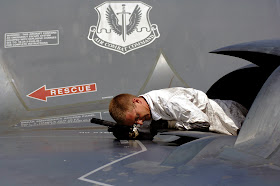
During Operation Allied Force/Noble Anvil,the bombing of the Federal Republic of Yugoslavia (now Serbia and Montenegro) in 1999,American B2 Spirit strategic bombers flew from Whiteman Air Force Base,Missouri in the United States of America.

19 B2 bombers were based at Whiteman.
Of these,10 were being upgraded to Block 30 standard and 9 were available for operations.

Of the 9 operational aircraft,1 was used for training,1 was receiving it's final Block 30 upgrades and 1 was undergoing extensive maintenance,leaving 6 aircraft available for combat.

During the 78 day bombing campaign,these 6 aircraft flew 49 sorties,45 of which reached their targets and released ordnance.
A sortie typically lasted 28-32 hours,required 4 in flight refuellings and delivered 16 guided 2,000 pound bombs.

B2 Spirits flew less than 1% of the sorties in Operation Allied Force yet they dropped 11% of all bombs.

Furthermore,while other aircraft were often unable to drop bombs due to bad weather,the B2s flew above the clouds using radar and inertial/Global Positioning System (G.P.S.) guided bombs regardless of the weather conditions.
On a per sortie basis the B2's bombing performance was far better than most other aircraft used in this conflict.
It has been said that "The B–2 was the star of the air campaign over Kosovo".

The total purchase cost of 21 B2 Spirits was $44,754 Million.
See here: www.fas.org/man/gao/nsiad97181.htm
Just 6 of these were used in Operation Allied Force due to the upgrades already mentioned.
However,the difficulty in maintaining the low radar signature of these aircraft is such that they can require 124 hours of maintenance for each hour of flight.
Consequently they have mission capable rates as low as 26% and rarely more than 50%.
This means that typically only 5-10 aircraft are available for use at any one time anyway.
See here: www.globalsecurity.org/wmd/systems/b-2-ops.htm and here: www.fas.org/man/gao/nsiad97181.htm

It had then actually cost $7,459 Million to field each of the six Spirits used in Operation Allied Force.
Approximately 700 bombs were dropped by B2s during the 78 day campaign with a hit rate of around 87%.

That is a rate of 1.5 bombs dropped per aircraft per day or 1.3 bomb hits per aircraft per day at a cost of $7,459 Million per aircraft.
That does not include the cost,approximately $800 Million,of the four tankers required to get the strategic bombers to their targets in the first place.

The total capital cost of around $8,300 Million for the B2 bomber and it's supporting tankers is similar to the cost of a British Queen Elizabeth class aircraft carrier and it's airwing.

Yet the aircraft carrier,operating from the Adriatic Sea,could deliver at least 100 times as many bombs on target per day as the bomber and do so without any aerial refuelling support as all targets would be within the unrefuelled tactical radius of it's aircraft.
Whether the carrier is equipped with Super Hornets,Rafales,Typhoons or Lightning IIs (F35 B or F35 C),all targets in the Federal Republic of Yugoslavia would lie within the unrefuelled tactical radius of it's aircraft when carrying 4 2,000 pound bombs.
No target being more than 300 miles from potential operating locations of the carrier.

If each of the 36 aircraft onboard such a carrier flew just one strike mission per day they would between them deliver 144 2,000 pound bombs in a day.
It is possible for a carrier to generate far more sorties than that.
British carrier aircraft were flying as many as 4 sorties per aircraft per day during the Falklands war in 1982.
The American aircraft carrier U.S.S Nimitz has demonstrated the ability to fly 200 strike sorties per day,4 sorties flown per fighter per day for 4 days,her captain thought she could have kept that rate up for a week.
The next generation American carrier U.S.S.Gerald R. Ford is designed to generate up to 5 strike sorties per aircraft per day.

Given the short distances involved,each sortie from a carrier in the Adriatic would take about one hour.
Under combat conditions carriers can turn aircraft around between sorties in under an hour,giving a total cycle time of about two hours per sortie over the Federal Republic of Yugoslavia.
There is then the time for the carrier to generate as many as many as 5 sorties per aircraft in a single day while still leaving plenty of time for rest and maintenance.
Such a sortie rate would deliver 720 2,000 pound bombs in one day.
That is as many bombs delivered in a single day as the entire B2 bomber fleet dropped in 78 days of Operation Allied Force.
Which is rather impressive when one considers that the bombers and their tanker support cost 5 times as much as the carrier and it's air wing.
It is also 480 times as many bombs dropped per day as could be delivered by a single B2 Spirit and it's tankers at the same capital cost as the carrier and it's air wing.
In terms of bombs per day per dollar,even when one allows for the cost of the aircraft carrier's escort support ships and availability of ships and aircraft,the B2 Spirit still appears to offer exceedingly poor value for money.

















